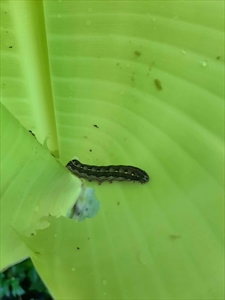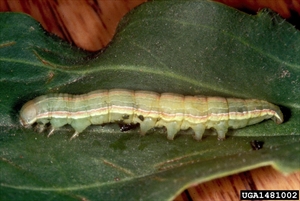The species damaging to shallot in Pacific island countries has not been identified. In this fact sheet, it is assumed to be either Spodoptera exigua (common cutworm, beet armyworm, small mottled willow moth), or Spodoptera litura (taro cluster caterpillar) (see Fact Sheet no. 31).
Pacific Pests, Pathogens and Weeds - Online edition
Pacific Pests, Pathogens & Weeds
Shallot Spodoptera army worm (178)
Spodoptera exigua (or Spodoptera litura). Confirmation required.
South and Southeast Asia, Africa, North and Central America, the Caribbean, Europe, the Middle East, Oceania. Spodoptera exigua is present in Australia, and Spodoptera litura is present throughout the Pacific islands (see Fact Sheet No. 31).
Very wide, including onion and relatives, especially shallots, but also food legumes, and members of the potato and cabbage families. Also on cotton and soybean.
The caterpillars eat the leaves - the young ones feed on the outside scraping the surface, the larger ones make irregular holes in the leaves or eat the leaves completely (Photo 1).
Spodoptera exigua: The female lays pale greenish or pinkish, striated eggs, in masses that are covered with white, cottony material (bristles from the body of the female). Each egg mass contains 50-150 eggs, each about 0.7 mm diameter. Larvae stay together after they hatch; later, they spread out and each one stays alone, one or two per plant as the larger stages are cannibalistic. There are five larval stages. They are pale green or yellow at first, and become a dull green with wavy, light coloured stripes down the sides below the breathing holes, and a broader dark brown stripe above (Photo 3). Another stripe runs down the top of the body. When mature they are 30 mm long. Pupation takes place in the ground; the pupae are light brown, 15-20 mm long. After 6-9 days, the adult emerges at night; it is a small, mottled grey or dusky-winged moth (Photo 5).
The life cycle is about 25 days, and during that time the female lays between 300 and 600 eggs. These are laid on the leaves.
The adult Spodoptera exigua is a stronger flyer; in North America there is an annual migration northward. The caterpillars are known to swarm and travel large distances in search of food.
Spodoptera litura: The cream to golden-brown egg masses (4-7 mm diameter) are covered with hairy scales from the tip of the abdomen of the female. After hatching, the caterpillars stay together (hence the name 'cluster caterpillar'). They vary in colour: pale green at first, then dark green to brown (Photo 2). There have bright yellow stripes along the top of the body. The caterpillars moult five times during 15-30 days, depending on the temperature. Afterwards, they pupate in the soil for 7-10 days. The body of the moth is grey-brown, 15-20 mm long, with a wingspan of 30-40 mm (Photo 7). The forewings are grey to reddish brown with a strongly variegated pattern; the hindwings are greyish-white with grey margins (Photo 4). The moths can fly up to 1.5 km a night. They are attracted to light.
Usually, Spodoptera species are minor pests of shallots in the Pacific islands. However, very damaging infestations are recorded in Indonesia, where large areas of shallot and onion are grown. There are reports of yield losses of more than 50% due to Spodoptera exigua. There have also been major outbreaks of Spodoptera exigua on cotton and soybean in the USA.
Look for the scrapings on the outside of the leaves of onions or shallots, and irregular but large holes in the leaves. Look for the caterpillars and check the number and colour of the stripes along the body.
NATURAL ENEMIES
A large number of predators and parasitoids attack the life stages of Spodoptera species (see Fact sheet no. 31), and usually keep them under control. In Indonesia, farmers are taught how to collect and use nuclear polyhedrosis virus as a spray. This is used as a control measure together with handpicking the caterpillars.
CULTURAL CONTROL
A number of cultural control measures are practised to keep Spodoptera species under control. These include:
During growth:
- Handpick caterpillars; this should be the first control measure tried.
- Remove weeds from within and around plots of onions and shallots.
- Grow shallots in a screened enclosure. The screen can be reused several times.
- Carry out mass trapping using light traps placed in the fields, if electricity is available
After harvest:
- Do not plant one crop of shallots on the same ground, year after year. Leave a break of 1-2 years. Rotations avoid the possibility that pupae in the soil hatch and the moths infest the new crop.
CHEMICAL CONTROL
If pesticides are necessary, use botanical (plant-derived pesticides) sprays first, as these cause less harm to natural enemies, and cost less than synthetic commercial products.
- Use neem, derris, pyrethrum or chilli. If these are used, add soap to help the chemical reach the caterpillars within the leaves.
- Alternatively (and preferably), use commercial biopesticides, e.g., spinosad (the product is called Success) or Bt - Bacillus thuringiensis var. kurstaki.
- If using Bt, note the following:
- Ensure that Bt covers the plants; caterpillars will only die if they eat the Bt.
- Eggs are not susceptible to Bt.
- Bt should be used as soon as damage is seen.
- Small larvae are more susceptible to Bt than fully grown ones.
- Synthetic pyrethroids are likely to be effective, but will also kill natural enemies.
____________________
When using a pesticide, always wear protective clothing and follow the instructions on the product label, such as dosage, timing of application, and pre-harvest interval. Recommendations will vary with the crop and system of cultivation. Expert advice on the most appropriate pesticide to use should always be sought from local agricultural authorities.
AUTHOR Grahame Jackson & Mani Mua
Information for Spodoptera litura: from Carmichael A, et al. (2008) TaroPest: an illustrated guide to pests and diseases of taro in the South Pacific. ACIAR Monograph No. 132, 76 pp. (https://lrd.spc.int/about-lrd/lrd-project-partners/taropest); and from Carmichael A (2008) Cluster Caterpillar (Spodoptera litura). PaDIL - http://www.padil.gov.au. Information on Spodoptera exigua: from MAF Plant Health & Environment Laboratory (2011) Beet armyworm (Spodoptera exigua): PaDIL - http://www.padil.gov.au; and Capinera JL (2020) Beet armyworm. Featured Creatures. UF/IFAS. University of Florida. (http://entnemdept.ufl.edu/creatures/veg/leaf/beet_armyworm.htm); and Spodoptera exigua (Hubner, 1808) (undated) Atlas of Living Australia. (https://bie.ala.org.au/species/urn:lsid:biodiversity.org.au:afd.taxon:35e15238-b120-49c9-a3d7-0bd177c3afad); and from Basuki SR (2011) Farmers' knowledge and effectiveness of insecticide uses by farmers in controlling Spodoptera exigua on shallots in Brebes and Cirebon. Indonesian Journal of Agriculture 4(1): 22-32. (https://ei-ado.aciar.gov.au/supplementary-reports/annotated-bibliography/farmers-knowledge-and-effectiveness-insecticide-uses.html). Photo 1 Ooi P (Image ID 38351). Photo 3 Frank Peairs, Colorado State University, Bugwood.org. Photo 5 Robert J. Bauernfeind, Kansas State University, Bugwood.org.
Produced with support from the Australian Centre for International Agricultural Research under project PC/2010/090: Strengthening integrated crop management research in the Pacific Islands in support of sustainable intensification of high-value crop production, implemented by the University of Queensland and the Secretariat of the Pacific Community.








